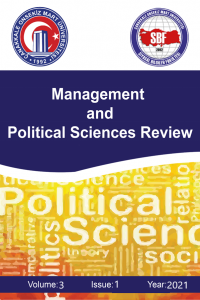The Impact of Accounting Information Systems (AIS) on Fraud Detection
The Impact of Accounting Information Systems (AIS) on Fraud Detection
This paper examines whether fraudulent activities in financial statements have decreased with the use of computerized accounting information systems (CAIS) and what can be done by accounting information systems (AIS) to decrease fraud in financial statements. Studies show that using computerized accounting information systems do not decrease fraud each time because top management instead of lower level employees is the one who commits crimes. Although enterprise resource planning systems (ERP) provide controls such as segregation of duties, they may not be sufficient to detect fraud. Instead, data mining techniques such as neural networks, decision trees and Bayesian Belief Networks may be used.
___
- Bayraktar, A., (2007). Türkiye’de Muhasebe Hileleri Tarihi, Master’s Thesis, Trakya Üniversitesi, Sosyal Bilimler Enstitüsü, Edirne.
- Beneish, M. D., (1997). Detecting GAAP Violation: Implications for Assessing Earnings Management Among Firms with Extreme Financial Performance, Journal of Accounting and Public Policy, 16 (3), 271-309.
- Best, P. T., Rikhardsson, P. & Toleman, M., (2009). Continuous Fraud Detection in Enterprise Systems through Audit Trial Analysis, Journal of Digital Forensics, Security and Law, 4(1), 39-60.
- Cerullo, M. J. & Cerullo V., (1999). Using Neural Networks to Predict Financial Reporting Fraud, Computer Fraud & Security, 5, 14–17.
- Cressey, D. R., (1973). Other People's Money: A Study in the Social Psychology of Embezzlement, Montclair: Patterson Smith, N.J.
- Cullinan, C. P. & Sutton, S. G., (2002). Defrauding the Public Interest: A Critical Examination of Reengineered Audit Processes and the Likelihood of Detecting Fraud, Critical Perspectives on Accounting, 13, 297-310.
- Daoud, H. & Triki, M., (2013). Accounting Information Systems in an ERP Environment and Tunusian Firm Performance, International Journal of Digital Accounting Research, 1-35.
- ERP Accounting Software: Preventing Fraud - Clients First. Retrieved September 15, 2016, from http://clientsfirst-tx.com/erp-accounting-software-preventing-fraud/.
- Fong, Q., (2014). Innovation of Techniques, Tools, and Technology in Audit: The Future of Electronic Audit and Fraud Detection, Term Paper, University of Waterloo.10. Hunton J., Wright, A, & Wright S, (2001), Business and Audit Risks Associated with ERP Systems: Knowledge Differences Between Information Systems Audit Specialists and Financial Auditors, Working Paper.
- Insurers: Victim Impact Statements. Victim Impact Statements, N.p., Retrieved December, 2016, from http://www.insurancefraud.org/the-impact-of-insurance-fraud.htm#.VhktFOztlHw
- Islam, A., Corney, M., Mohay, G., Clark, A., Bracher, S., Raub, T. & Flegel, U, (2011). Detecting Collusive Fraud in Enterprise Resource Planning Systems, Chapter Advances in Digital Forensics, IFIP Advances in Information and Communication Technology, 12 (361), 143-153.
- Kirkos, E., Spathis, C. & Manolopoulos, Y, (2007). Data Mining Techniques for the Detection of Fraudulent Financial Statements, Expert Systems with Applications, 32 (4), 995-1003.
- Kuhn, J. R. & Sutton, S. G, (2006). Learning from WorldCom: Implications for Fraud Detection through Continuous Assurance, Journal of Emerging Technologies in Accounting, 3 (1), 61-80.
- Küçükkocaoğlu, G., Benli & Y. K., Küçüksözen, C., (1997). Finansal Bilgi Manipülasyonunun Tespitinde Yapay Sinir Ağı Modelinin Kullanımı, İMKB Dergisi, 9 (36), 1-30.
- Little, A.G. & Best, P.J., (2003). A Framework for Segregation of Duties in an SAP R/3 Environment, Managerial Auditing Journal, 13(5), 419-430.
- MacDonald, E., (1998). Cendant’s Former Auditor Suggests it was Misled, The Wall Street Journal, p. A3
- Managing the Business Risk of Fraud: A Practical Guide, (2008), Publication sponsored by The Institute of Internal Auditors, Association of Certified Fraud Examiners, and The American Institute of Certified Public Accountants.
- Persons, O., (1995). Using Financial Statement Data to Identify Factors Associated with Fraudulent Financial Reporting, Journal of Applied Business Research, 11(3), 38–46.
- Sharma, P., (2004). Enterprise Resource Planning, 1st Edition, Aph Publishing Corporation.
- Sharma, A. & Panigrahi, P. K., (2012). A Review of Financial Accounting Fraud Detection Based on Data Mining Techniques, International Journal of Computer Applications, 39 (1).
- Stice, J., Albrecht, S. & Brown, L., (1991). Lessons to be learned - ZZZZBEST Regina and Lincoln savings, The CPA Journal, 52–53.
- Turner, L. & Weickgenannt, A. B., (2013). Accounting Information Systems: The Processes and Controls, 2nd Edition, Wiley.
- Uğurlu, M & Sevim, Ş., (2015). A Comparative Analysis on the Relative Success of Mixed-Models for Financial Statement Fraud Risk Estimation, Gaziantep University of Social Sciences, 14 (1), 65-88.
- Welch, S., Madison, T. & Welch, O, (2011). An Analysis of Computer Fraud: Schemes, Detection, and Outcomes, Issues in Information Systems, 12(1), 206-212.
- ISSN: 2636-8684
- Yayın Aralığı: Yılda 2 Sayı
- Başlangıç: 2018
- Yayıncı: Çanakkale Onsekiz Mart Üniversitesi
Sayıdaki Diğer Makaleler
Mesafenin Devlet Üniversiteleri Kayıtları Üzerindeki Etkisi: ÇOMÜ Örneği
ÖRGÜT İKLİMİ VE POZİTİF PSİKOLOJİK SERMAYENİN ETİK DAVRANIŞLAR ÜZERİNDEKİ ETKİSİ
Gülten GÜMÜŞTEKİN, Merve Gözde DURMAZ
METODOLOJİK AÇIDAN LİSANSÜSTÜ BİTİRME TEZLERİ ÜZERİNE NİTEL BİR ARAŞTIRMA
The Impact of Accounting Information Systems (AIS) on Fraud Detection
ANTİ-SOSYAL DAVRANIŞLAR ÜZERİNE KAVRAMSAL BİR İNCELEME
TEDARİKÇİ SEÇİM KRİTERLERİNİN BULANIK VIKOR İLE BELİRLENMESİ
